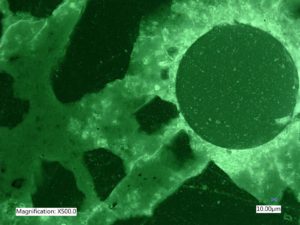Concrete Thin Section Fluorescence
Fluorescence is a valuable tool in the concrete petrographic world, especially for the examination of thin sections (on the order of 20μm). There are a variety of techniques for introducing the fluorescence to the sample, most commonly by impregnating the sample under vacuum with an epoxy containing a fluorescent dye, or by replacing the water in the sample with a fluorescently marked ethanol.
Fluorescence can make features of interest stand out in high contrast, or can be compared to a reference to make quantitative measurements. Among the characteristics that can be studied are:
- Pore size and location
- Water to cement ratio
- Microstructure
- Fractures and cracks
Once the fluorescence has been introduced to the sample it is generally examined under a microscope. The NIGHTSEA Model SFA fluorescence adapter system is a simple and economical way to add a versatile fluorescence viewing capability to existing microscopes that operate at a wide range of scales. The dyes used in the concrete examination process are very strongly fluorescent and are excited well by ultraviolet (UV) or blue light. (Note – while the provider of the dye recommends use of UV, our experience is that our Royal Blue light source plus filter combination provides superior results for this and many other fluorescent indicators used in this and related applications.)
The images of concrete thin section fluorescence below were made with a DSLR camera (top row), a stereo microscope (second row), and a Keyence VHX series digital microscope with the VH-Z100 lens (rows three and four). NIGHTSEA’s Royal Blue excitation was used for all images.
- Fluorescein conrete thin section
- Macro Image of concrete thin section, white light
- Concrete thin section under blue light excitation
- Concrete thin section, white light
- 100x
- 200x
- 500x
- 700x
We are grateful to the Department of Mineralogy and Geochemistry, Institute of Geoscience and Geography, University Halle-Wittenberg, Germany for providing the sample for testing. For more information about the sample or the imaging process please contact NIGHTSEA.
Links:
- Stereo Microscope Fluorescence Adapter
- Fluorescence Adapters for Keyence Series Digital Microscopes
- https://www.concrete.org/








